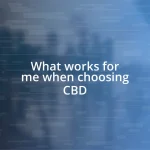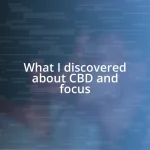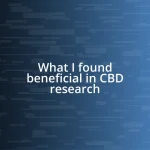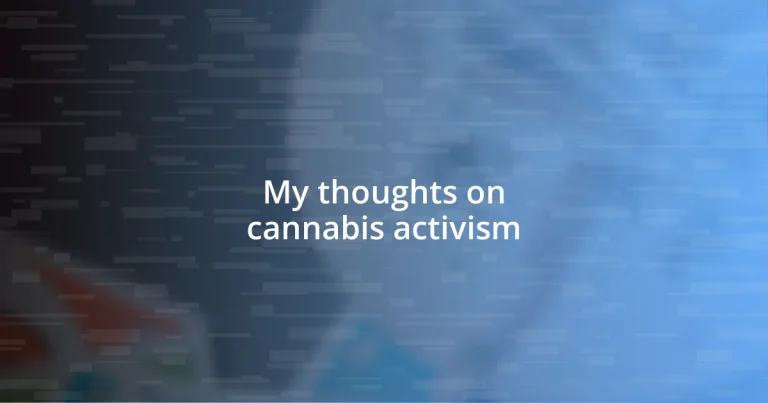Key takeaways:
- Cannabis activism emphasizes personal narratives and community engagement to advocate for understanding, access, and legalization of cannabis for medical and recreational use.
- Reforming cannabis policies addresses public health, social justice, and economic opportunities, highlighting the need for equitable access and the positive outcomes of legalization.
- Effective advocacy strategies include personal storytelling, coalition-building, and utilizing social media, enhancing the visibility and impact of the movement.
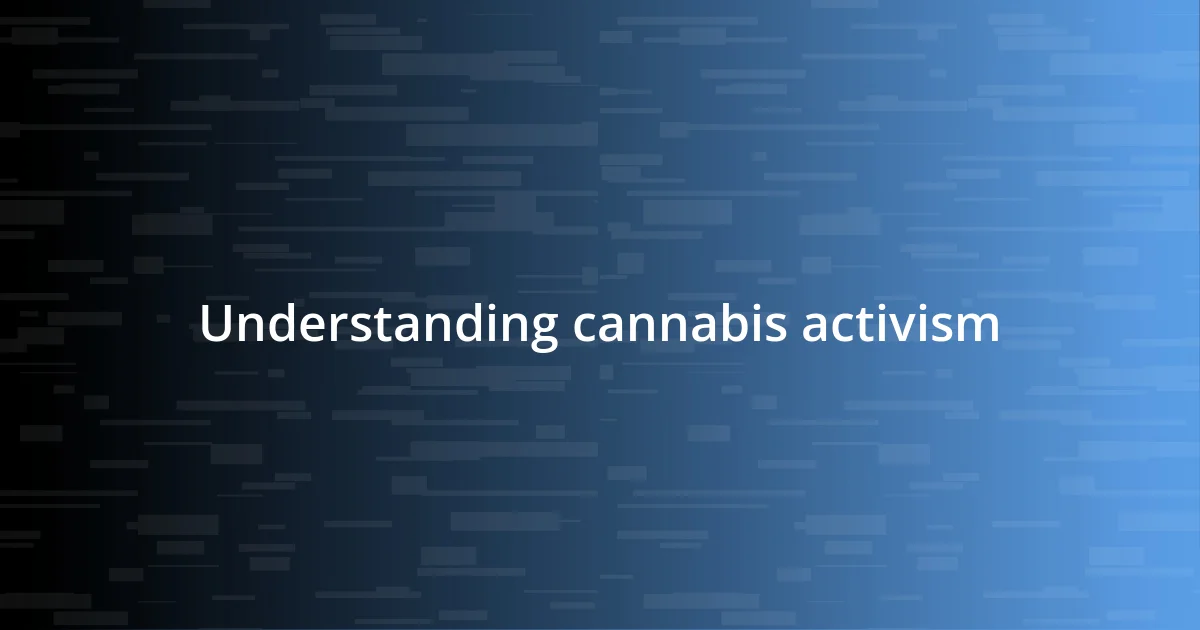
Understanding cannabis activism
Cannabis activism is a movement that aims to promote the understanding, access, and legalization of cannabis for medical and recreational use. I remember attending a local rally where passionate speakers shared their stories about how cannabis changed their lives, whether through pain relief or enhancing their quality of life. It made me realize that behind every statistic, there’s a personal narrative that fuels this movement—how can we ignore the powerful voices of those who have benefited?
The emotional charge of cannabis activism often stems from its historical context. For many, advocating for cannabis is also a fight against the stigma surrounding it, shaped by years of misinformation and legal repercussions. I’ve felt the frustration when friends express skepticism about cannabis because of what they’ve heard rather than what they’ve experienced. This makes me wonder: how can we bridge that gap and educate those who are still in the dark?
Activists use various tools—social media campaigns, grassroots advocacy, and personal testimonies—to push for change. I vividly recall a campaign that went viral, showcasing individuals sharing their life-changing experiences with cannabis. It was inspiring to see how creativity and storytelling could mobilize a community toward a common goal. This raises an intriguing notion: Aren’t we all storytellers at heart, shaping perspectives and driving change one conversation at a time?
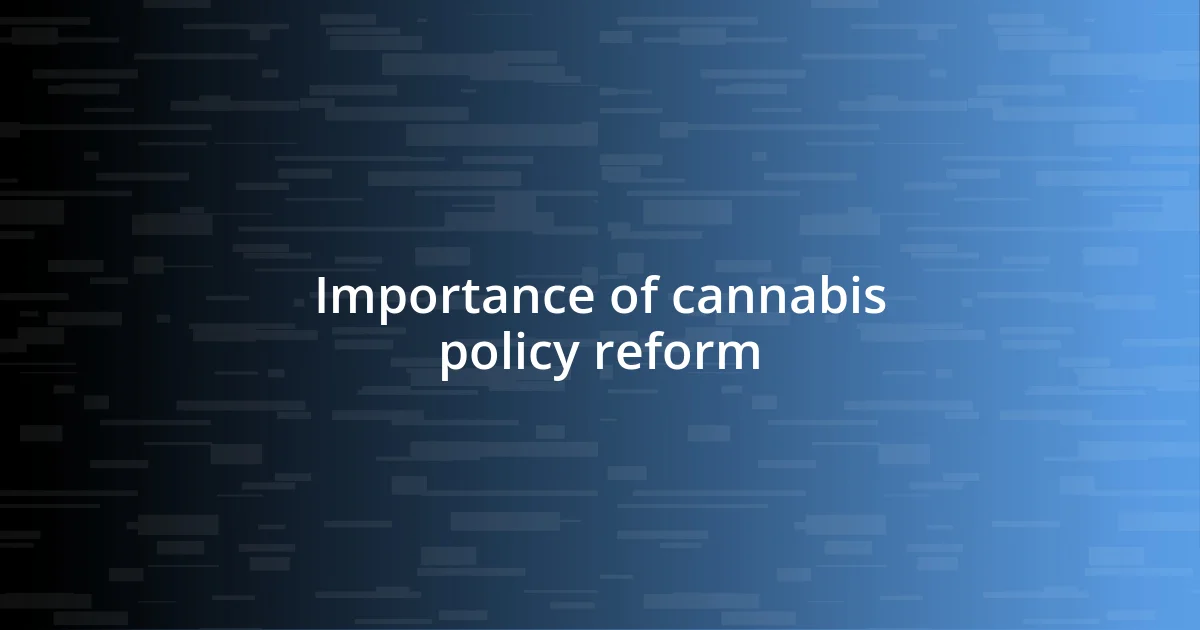
Importance of cannabis policy reform
The importance of cannabis policy reform cannot be overstated. From my perspective, effective policy change leads to better public health outcomes and safer communities. I’ve spoken with patients who rely on cannabis for their well-being, and their urgency for reform often reflects not just personal need but a collective demand for justice and accessibility. How can we justify keeping potentially life-saving medications out of reach?
Moreover, reforming cannabis policies addresses systemic inequalities. I remember sitting in a discussion where individuals shared stories about being disproportionately impacted by previous harsh laws—people lost jobs, families were strained, and yet, society still casts a shadow over their experiences. Changing these policies isn’t merely a legal issue; it’s a matter of human rights, dignity, and fairness. I can’t help but think, isn’t it time we advocate for those long silenced by outdated regulations?
Lastly, I see cannabis policy reform as a gateway to economic opportunities. In my community, we’ve witnessed new job creation and business growth following legalization efforts. It’s invigorating to hear entrepreneurs share how cannabis has transformed their lives, not just financially, but also in terms of empowerment and community building. When policy evolves, it unlocks potential—how could society not embrace such a shift?
| Key Aspect | Description |
|---|---|
| Public Health | Improved access to medical cannabis can enhance health outcomes for patients. |
| Social Justice | Reform addresses inequalities in the legal system and promotes fairness. |
| Economic Opportunity | Legalization creates jobs and fosters new business growth. |
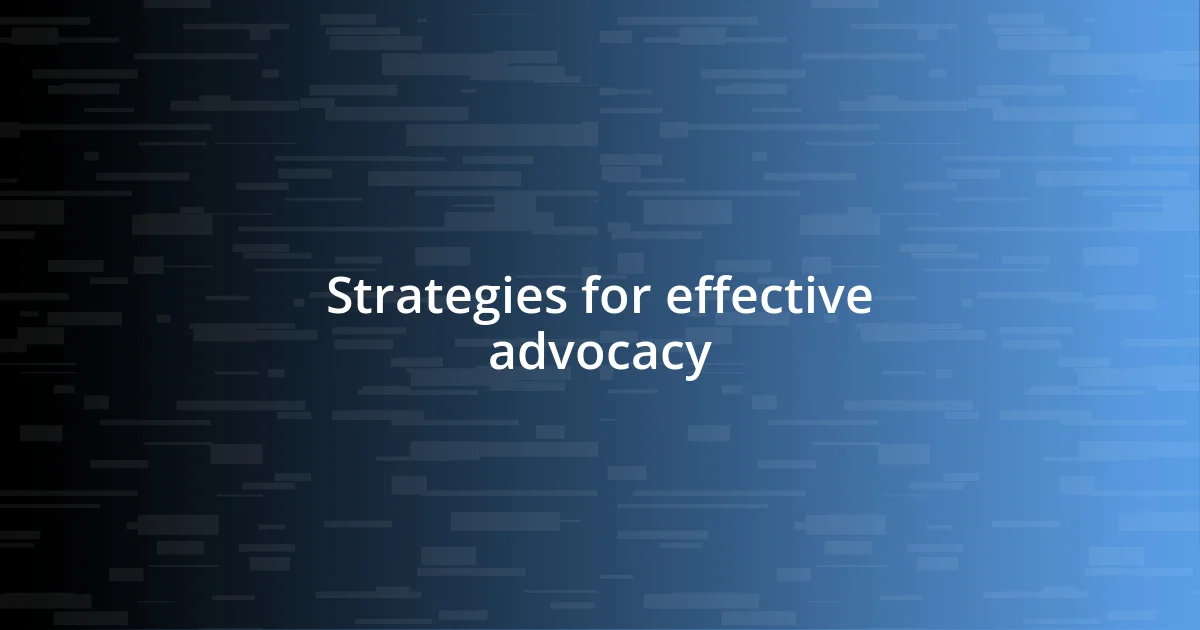
Strategies for effective advocacy
Advocacy for cannabis reform requires a multi-faceted approach that resonates with varying audiences. I often find that the most impactful advocates are the ones who personalize the message — telling their stories is essential. I once overheard a parent share how cannabis transformed their child’s battle with epilepsy; the emotional weight of their testimony was palpable. It reminded me that facts alone won’t sway hearts; the narratives we share can evoke empathy and motivate action.
Here are some effective strategies for advocacy that leverage both personal stories and community engagement:
- Personal Narratives: Sharing genuine experiences creates emotional connections that statistics alone can’t achieve.
- Community Events: Organizing local gatherings or educational workshops fosters dialogue and builds a supportive network.
- Coalition Building: Partnering with like-minded organizations amplifies voices and resources, enhancing visibility and impact.
- Social Media: Utilizing platforms to share stories, campaigns, and resources makes it easier to engage with a broader audience.
- Legislative Engagement: Encouraging direct contact with legislators through letter-writing campaigns or meetings helps solidify advocacy efforts.
It’s crucial to adapt our approach based on the audience we’re addressing. For instance, I’ve seen how a tailored approach during high school presentations sparked curiosity among students who had never considered the medicinal benefits of cannabis. Knowing your audience allows advocates to frame their messages in ways that resonate deeply and inspire action. Ultimately, it’s about creating a tapestry of voices that represent both personal experiences and cherished values.
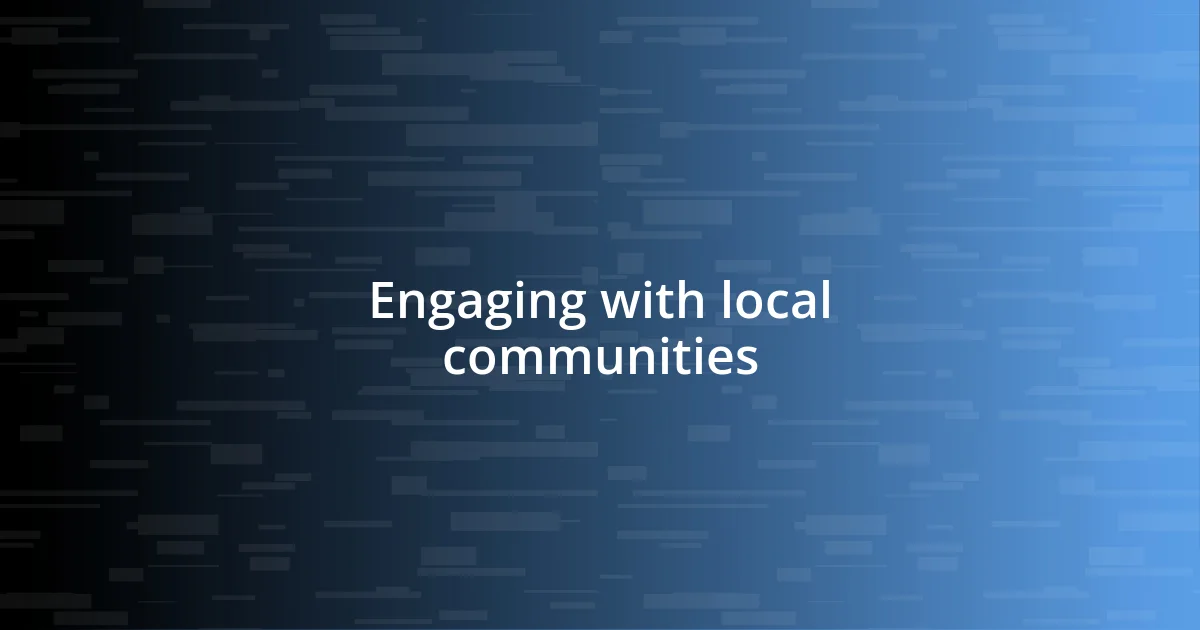
Engaging with local communities
Engaging with local communities is vital for cannabis activism. I’ve witnessed firsthand how town hall meetings can transform mindsets. In one instance, a group of concerned parents approached me after a presentation, sharing their fear of losing access to medical cannabis for their children. Their genuine anxiety opened a dialogue about the need for education and reform, showing me that real connections begin at the local level.
Participation in community events also proves invaluable. I once organized a small festival where local artists and cannabis advocates shared their perspectives. The tangible energy and enthusiasm from the crowd sparked conversations that challenged stereotypes surrounding cannabis. It reinforced for me that when people come together, they can shift perceptions and build a base of support that feels immediate and personal. Isn’t it incredible how shared experiences can dismantle preconceived notions?
Moreover, forming partnerships with local organizations can amplify our message significantly. I remember collaborating with a health clinic for an awareness campaign, which not only educated community members but also fostered a sense of unity. By aligning with groups already embedded in the community, we created a movement grounded in trust and mutual respect. Engaging locally creates a ripple effect—how often do we realize the profound impact we can make together?

Building coalitions and partnerships
Building coalitions is an essential aspect of advancing cannabis activism. I remember a particularly eye-opening event where we collaborated with a group focused on mental health advocacy. Their insights and experiences brought a new dimension to our discussions, highlighting how cannabis can play a role in mental wellness. This partnership made me realize how critical it is to find common ground with diverse organizations, as it enhances our credibility and reach.
Additionally, I’ve learned that effective coalition-building often requires patience and understanding. Early on, I tried to push for a unified message without considering the varying missions of potential partners. It was only after a few missteps that I understood the value of listening. By engaging in open dialogue, I discovered shared goals that allowed us to create a more cohesive strategy. Don’t you think it’s interesting how listening can sometimes be the secret ingredient in forging strong alliances?
When we form coalitions, our collective narratives become more powerful. I recall collaborating with environmental groups to emphasize the sustainable aspects of cannabis agriculture. Sharing our stories about the benefits of responsible farming practices created a compelling narrative that resonated with a broader audience. This experience taught me that the more inclusive our partnerships, the stronger our advocacy becomes. Isn’t it amazing how a diverse coalition can elevate the conversation and foster a sense of shared purpose?
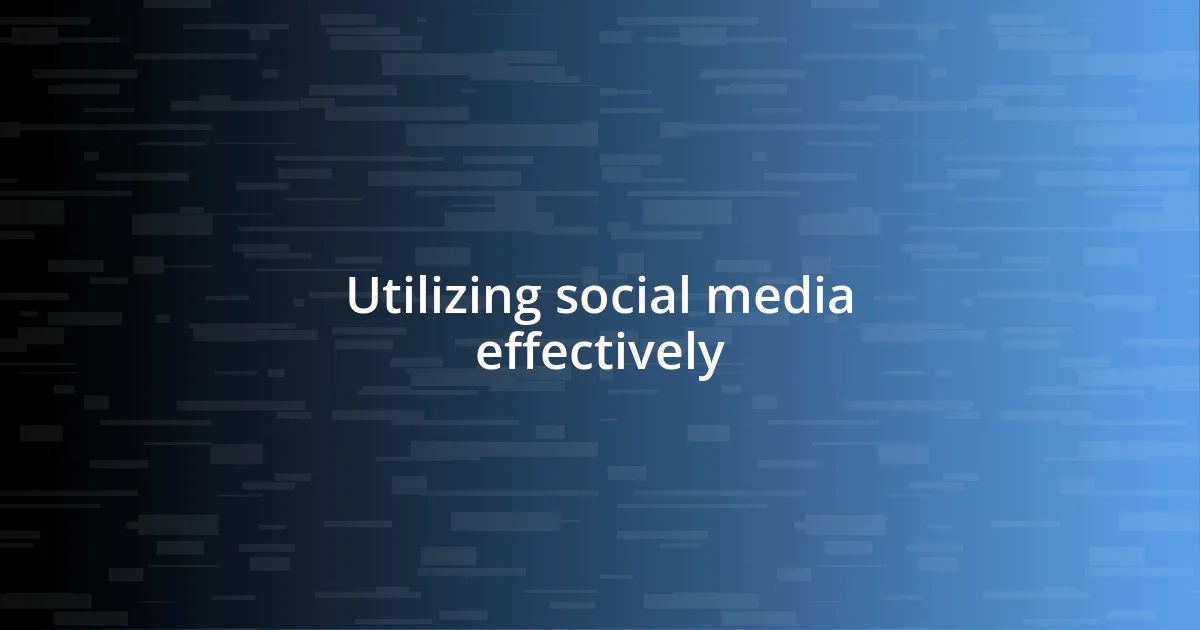
Utilizing social media effectively
Social media has become a powerful tool in cannabis activism, allowing us to reach audiences far beyond our immediate circles. I remember creating a short video that explained the benefits of cannabis legislation in a straightforward way. The response was overwhelming—people began sharing it, and within a few days, it had reached thousands. Isn’t it fascinating how a single post can ignite discussions and even spark movements?
To harness social media effectively, consistency is crucial. I’ve found that regularly sharing updates, personal stories, and educational content not only keeps followers engaged but also builds trust over time. For instance, I started a weekly series where I answered questions about cannabis laws in our state. The direct interaction with followers reinforced my belief that authenticity and transparency are key. Have you ever noticed how a personal touch can make complex issues feel relatable?
Engaging with various social media platforms is also essential, as each has its distinct audience and culture. While Instagram works wonders for visual storytelling, I’ve discovered that Twitter is perfect for quick updates and real-time discussions. Once, during a Twitter chat about cannabis policy, I connected with advocates across the country, exchanging ideas and strategies live. It was electrifying to feel that surge of community spirit! How often do we get that chance to connect and innovate as activists in real-time?
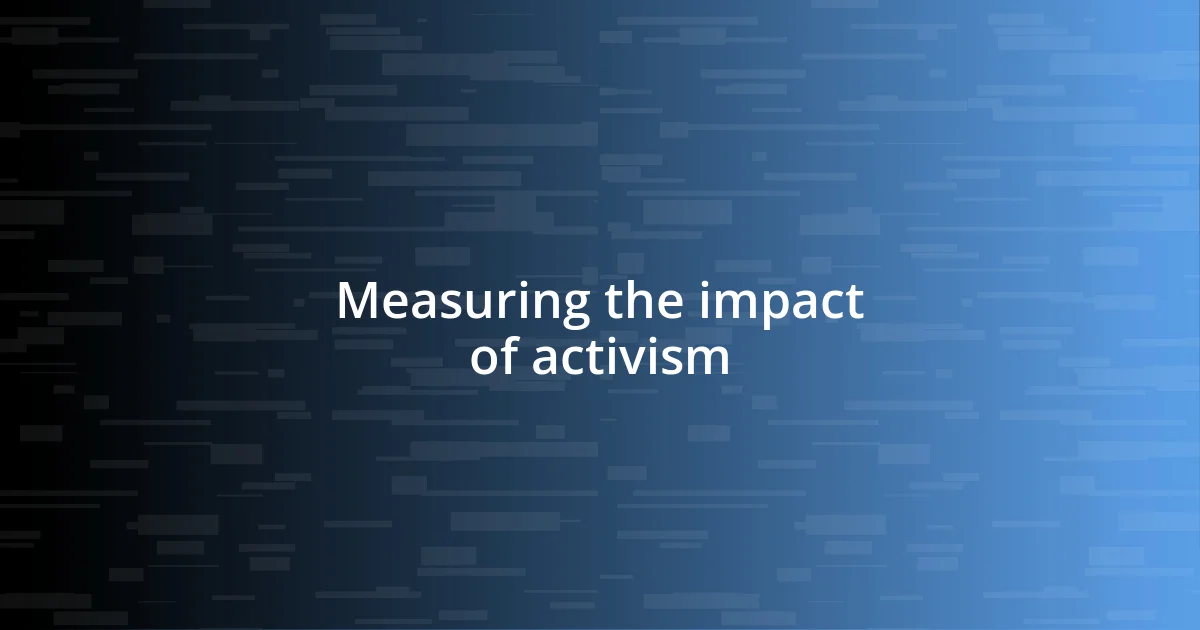
Measuring the impact of activism
Measuring the impact of activism is a nuanced task that often goes beyond immediate metrics. I remember attending a community forum where we discussed the effects of our campaigns on local legislation. By compiling testimonials from individuals whose lives improved due to cannabis policy changes, we painted a clearer picture of our impact—making statistics feel personal and relatable. How do we truly quantify success when so many lives are touched in unseen ways?
One approach I’ve found effective is tracking changes in public opinion. After launching awareness initiatives, we conducted surveys to assess shifts in attitudes toward cannabis use and legislation. The results showed not just a numerical change but an awakening of understanding among community members. It felt rewarding to witness this growth; it reaffirmed for me that grassroots activism can alter perceptions over time, almost like watching a flower bloom. Have you ever measured success in small victories that collectively make a powerful statement?
Additionally, engaging with the media has proven invaluable in measuring our activism’s reach. I recall a local newspaper featuring our efforts in a spotlight article that detailed our campaign’s achievements. The flood of new supporters and inquiries that followed was astounding. It made me realize that sometimes the conversations sparked offline can have a more profound effect than any single event. Isn’t it fascinating how the ripples of our actions can reach far beyond what we initially envision?
